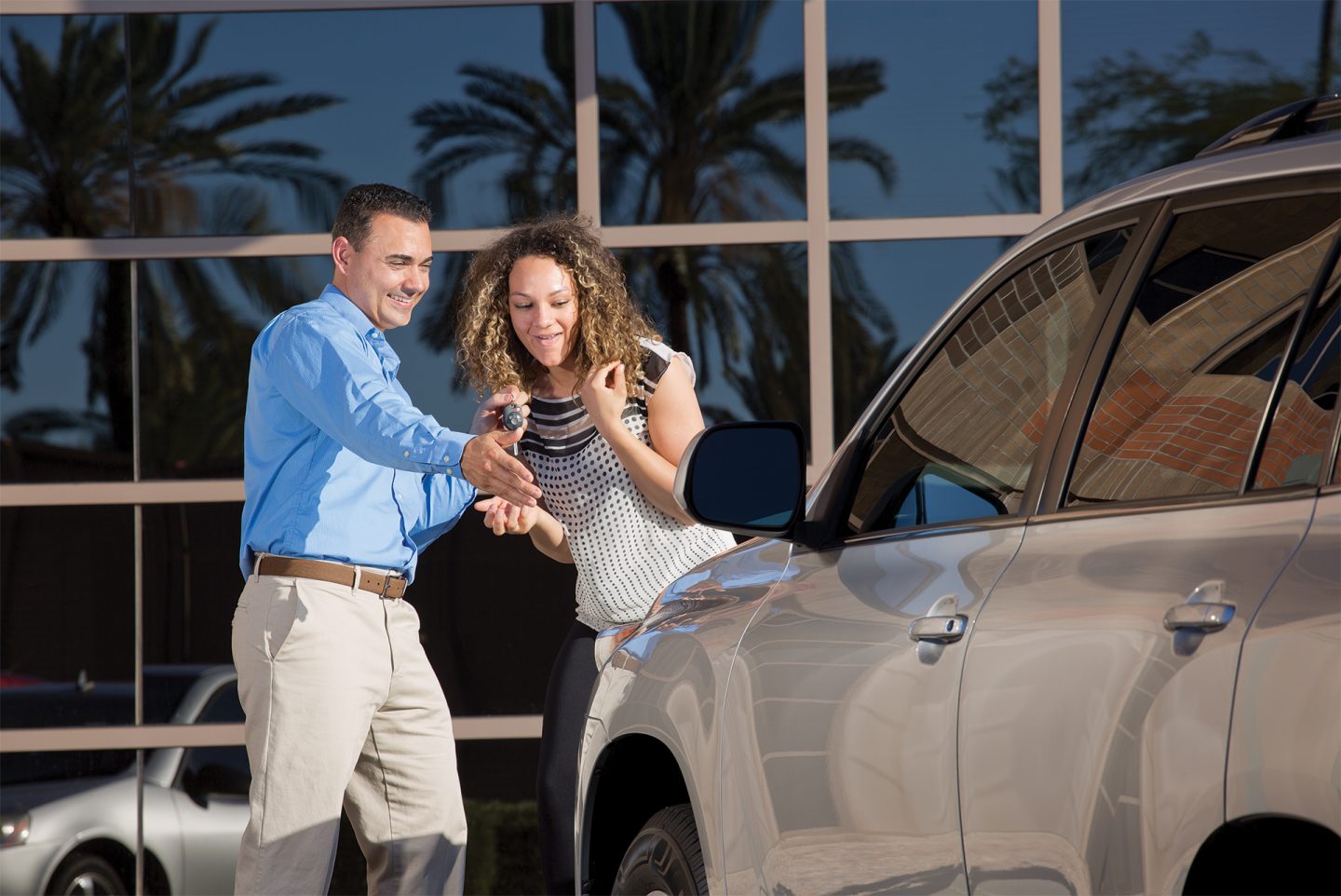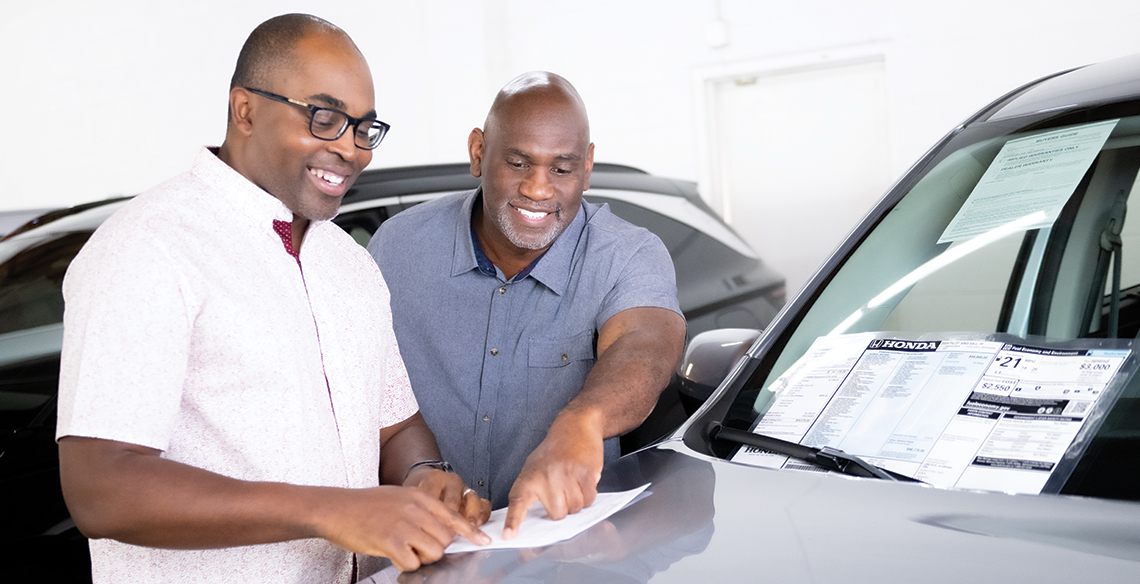At one point or another in your life, you’ll probably need to buy a vehicle. Car buying can easily become an emotional, rather than calculated, purchase. The last thing you want to do is spend $20,000 on something you love one day and regret the next. With proper research and patience, you can find the perfect car for a price you’re comfortable with.
The cost of ownership
While it’s perfectly fine to purchase the car of your dreams, you want to first ensure you can afford it. This means, before you go looking for your new car, you need to know how purchasing a new vehicle fits into your overall budget. Budget? Do you even have a budget? If not, now’s the perfect opportunity to create one. If you need help, resources are available online, or stop by the credit union for assistance.
If you’re like most of us, you’ll need to obtain financing rather than paying in cash. Getting preapproved before you begin looking for a new car will clue you in on how much the financial institution is willing to lend to you. While you may have done the math and figured you can afford the payment on a $20,000 auto loan; your loan application could come back with an approval of $15,000. On the other hand, you might be approved for a substantial dollar amount, but do the monthly payments associated with that loan fit into your overall spending plan?
Your monthly payment is just one part of the equation. While the vehicle you love may be within your price range, there may be additional expenses you need to consider.
- Cost of Fuel: How many miles do you drive? Most people drive an average of 32 miles per day. A $300 car payment doesn’t look too bad until you realize the vehicle only gets 16 miles per gallon. Using two gallons of gas a day can easily cause you to fill up at the pump every week, adding up to more than $100 a month in fuel expenses.
- Maintenance: All vehicles will need repairs and maintenance at some point. Check your target vehicle’s track record online to see if it’s in constant need of repairs. Some cars can be driven for hundreds of thousands of miles as long as you faithfully follow the recommended maintenance schedule.
- Insurance: Depending on the vehicle you purchase, your insurance premiums may change as well. Once you narrow down your search to what you’re looking to buy, call your agent. He or she can provide a quote of what your rate will be. If the quoted rate goes over your intended budget, it’s time to look for a different vehicle.
- Registration: The cost to register a vehicle is another consideration, and it can vary from state to state. In Arizona, vehicle registration is based on the manufacturer’s suggested retail price when the vehicle was new, plus a flat fee of $13.50 (visit www.azdot.gov/mvd for details). The registration fee is then depreciated every year. For example, a new vehicle with a base price of $25,000 would have a total registration cost of $434 for the first year, dropping to $376 for the second year.
Determining your needs
While the cost of gas, repairs, insurance, registration and financing are important topics to consider, there are many other points to evaluate when purchasing a new vehicle.
Think of how many people ride in your car. They may all fit in your current vehicle, but what about the car or truck you’re looking to buy? And what about any future additions to your family? If you have young children, you’ll want to make sure your new vehicle can accommodate car seats and additional baby gear. If you have teenagers, think about the extra space they’ll need, especially if they have lots of sports equipment to haul around. In the end, make sure the car is wide and long enough to comfortably accommodate yourself and all its intended passengers.
Speaking of size, have you checked the size of your parking space? Some garages are built to hold smaller vehicles. If you were to purchase a truck with an extended bed, for example, you may end up having to park diagonally in your garage or on the street. You’ll want to check the dimensions of the car and compare them to where you intend to park.
Depending on your driving patterns, some amenities may be considered a need, rather than a want. If your job requires you to drive around the Valley for eight hours a day, investing in a better stereo may be worth the extra money. Seat warmers are nice and fancy, but most of us live in a desert; we get warm seats for free! There are countless options you can add to your car. It’s up to you to decide which options are a want, which options are a need and how much more you’re willing to pay for these added features.
New vs. used
The age old question … should you buy new or used? Both have advantages and disadvantages. Buying a new vehicle typically means you’ll be driving something that needs fewer repairs, and if repairs are required, they may be covered by the manufacturer’s warranty. With a new vehicle, you don’t need to worry about problems the previous owner didn’t fix. It’s new, untouched and probably in the best condition it will ever be. The downside to buying a new vehicle? Overall, it’s a more expensive purchase.
A used car – depending on how old it is – may come with its own set of problems. There may be excessive miles, causing it to need more repairs. There may be stains and tears on the interior. And there are any number of little things that could be waiting to break. The upside is if you’re a savvy shopper and purchase a vehicle with a good track record, you can get a great car at a much better price.
While we all would love to buy a brand new car right off the assembly line, many financial experts recommend purchasing a 1 to 3-year-old vehicle. This allows you to get a practically new car at a much lower price. Not only that, but the risk of becoming upside down on the loan – when you owe more on the vehicle than it’s worth – is much greater with a brand new vehicle. (New vehicles can easily depreciate 30 percent in value within the first year.)
Where to buy
Now that you’ve weighed all your options of what you want to buy, it’s time to go shopping. The most common way people buy cars is through a dealership, which often provides a large selection. While you have many options to choose from, the sheer number of choices can be overwhelming. And, in some cases, the sales person will try to convince you to purchase a car you truly can’t afford or don’t really want. Just remember, it’s OK to walk away – regardless of where you’re looking. You’re buying this car for you. So get the car you want, not the car they want to sell you.
Buying a car from a private party can help save you some money. Purchasing a vehicle from an individual means you can avoid the dealer markup, which helps to cover their operating expenses, salaries and commission checks. While it may be cheaper to purchase a private party vehicle, there are a few drawbacks. If you have a particular car in mind, it may take you longer to find the one you’re looking for. Also, unlike dealerships who have mechanics to service the vehicles before selling, you don’t know if there are any hidden problems with the car. Experts recommend having the vehicle checked by a mechanic you trust before closing the deal on a private-party purchase. If the seller doesn’t like this idea, move on to another vehicle.
Also, consider what you’ll do with your current vehicle when you find a new one. If you buy from a private party, you most likely still have the vehicle and have to take the time to find a buyer. By going to a dealership, they’ll most likely offer to purchase your car and use that money to lower the price of your new car. Be careful! Avoid talking about your trade-in until you’ve negotiated a price on the new vehicle; the dealer may try to use the trade-in value to inflate your new car purchase price (while making it look like they’re lowering it). You’ll also want to avoid selling your current vehicle while you’re upside down on your current loan. If you do, the amount you’re upside down gets added to your new loan, causing you to be even more in debt for your new car than you want to be.
Want to sell the car yourself? You can often get more money by selling your vehicle to an individual compared to what most dealerships will offer on a trade-in. Dealerships want to purchase your old car for as little as possible. While they want to make a profit, they also have to cover their operating expenses and the cost of any repairs the vehicle needs before putting it up for sale. Go to the Kelley Blue Book website to get an idea of your current vehicle’s value, whether you trade it in or sell it yourself.
To get the benefit of both the dealerships and private party, consider using an auto broker. Auto brokers have your – the buyer’s – best interests in mind. Brokers provide their service at no direct cost to you, because the dealer pays them a finder’s fee. They will locate the vehicle you want, negotiate pricing and handle delivery. Brokers not only save you time and money, they also save you the hassle of contacting multiple dealers in hopes of finding the best deal. Because they purchase vehicles through commercial fleet accounts, they avoid the retail side and can usually get the dealer’s lowest price without all of the haggling. Some auto brokers can also handle the sale of your old vehicle. Similar to finding a vehicle to purchase at the lowest price, brokers will find a buyer for your old vehicle at the highest price.
Whichever option you choose, test drive the vehicle. While the new vehicle looks nice on the outside and comfortable on the inside, how it handles might not be a good fit for you. When you take the car out, make sure you drive it on surface streets and freeways, and check for blind spots to make sure you can see everything you need to. Everyone has their own style of driving. Before you sign anything, make sure the car is, literally, the right fit for you.
Closing the loan
You found it! The car you have been looking for is within reach. Since you’ve already been preapproved, closing your loan will be much simpler. For new vehicles, obtain a purchase order from the dealership or auto broker and supply that to your financial institution. If you’re buying from a private party, both you and the seller will most likely need to visit your financial institution in person. You’ll probably be asked to bring in some additional documentation (such as paystubs and proof of car insurance). To ensure the process goes smoothly, speak to your loan officer before going to the branch.
Before you close on your loan, consider purchasing:
- GAP – Helps cover the difference between what you owe and what your vehicle is worth if you total your new car before you have positive equity in it.
- Extended warranty – Pays for all costly repairs covered under the policy you purchase and can help save your pocketbook if your car breaks down.
Many people find these two add-on products are worth every penny. Your loan officer can help you weigh the pros and cons of each policy to determine if they’re a good fit for you. Also, make sure you shop around before you buy. While the dealership may offer these products to you, many financial institutions offer the same, if not better, products at a much lower price.
Once the loan documents are signed, the car is all yours, as long as you make your payments on time. Double check your loan documents to ensure you are familiar with the loan’s due date. The last thing you want is to forget the new due date and have a late fee on your first payment. Set up automatic payments from your checking account to make sure your new payment is made on time every month. If the automatically calculated due date does not work for you, talk to your loan officer. Many financial institutions will allow you to change the due date once the first monthly payment has been made.
Lastly, make sure you contact your insurance company to add your new vehicle to your insurance policy. You’ll also want them to send proof of insurance to the financial institution that funded your loan to ensure no additional costs are added to your auto loan, like forced-placed insurance.
What’s next you ask? You now get to enjoy every minute you spend in your new vehicle and make lifelong memories. Because you did your research and didn’t make an expensive impulse buy, you’ll be able to skip the buyer’s remorse.



